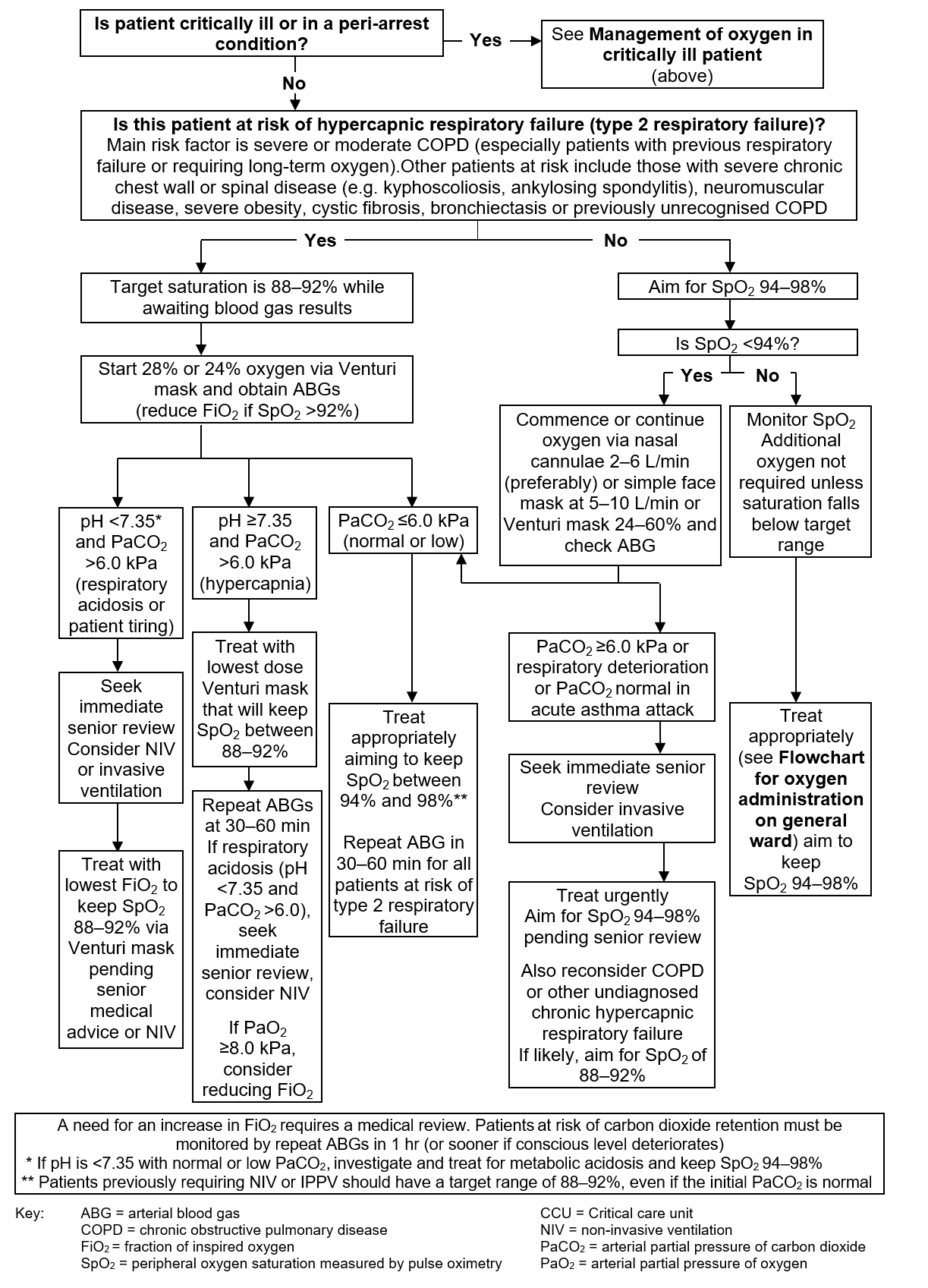DO NOT USE - ALL INFORMATION LIKELY INCORRECT IF NOT ACTIVELY DANGEROUS
Please use current guidelines available on the UHNM intranet for patient treatment
Please use current guidelines available on the UHNM intranet for patient treatment
AIM
- To maintain oxygen at the minimum concentration in the blood to achieve adequate tissue oxygenation and minimise the threat of oxygen or carbon dioxide toxicity
OXYGEN PRESCRIPTION
The three questions to ask
- Critical or non-critical illness?
- Risk of type 2 respiratory failure?
- Is the patient hypoxic?
MANAGEMENT OF OXYGEN IN CRITICALLY ILL PATIENT
- Follow ABC approach and address underlying cause
- Initial oxygen therapy is via reservoir mask at 15 L/min for patients with or without hypercapnia
- use bag-valve-mask for active resuscitation during cardiac/respiratory arrest
- Once stable and if not ventilated, take arterial blood gas
- choose oxygen saturation target for further oxygen therapy
MANAGEMENT OF OXYGEN IN NON-CRITICALLY ILL PATIENT
Flowchart for non-critical illness requiring moderate amounts of supplemental oxygen (see separate advice in guideline for high-risk post-operative surgical patients)

How to prescribe
- Oxygen saturation target:
- SpO2 88-92% for non-critical patients at risk of type 2 (hypercapnic) respiratory failure
- SpO2 94-98% for all other patients
- Oxygen flow rate
- Delivery device (e.g. Venturi mask, nasal cannulae, reservoir mask)
- Frequency (continuous or PRN use for palliative care only)
MONITORING
- Monitor SpO2 continuously
- If oxygen requirement increases, seek senior advice
- Closely observe patients at risk of CO2 retention for signs of reduced respiratory effort or conscious level (GCS <14 or V on the AVPU scale)
- if patient at risk of CO2 retention, repeat ABGs in 30-60 min after any further increase in FiO2 or if conscious level deteriorates
- Discuss any deteriorating patient with consultant responsible for management of co-morbidity and critical care team
Signs of respiratory deterioration - seek medical advice
- Increased respiratory rate (especially if >30/min)
- Reduced SpO2
- Increased oxygen dose required to maintain SpO2 in target range
- Increased NEWS score
- CO2 retention
- drowsiness
- headache
- flushed face
- tremor
Guidance on results of ABG
- Seek immediate senior review
- Consider NIV or invasive ventilation
- Treat with lowest FiO2 to keep SpO2 88–92% via Venturi mask pending senior medical advice or NIV
- Investigate and treat for metabolic acidosis and keep SpO2 94–98%
- Treat with lowest dose Venturi mask that will keep SpO2 between 88-92%
- Repeat ABGs at 30–60 min
- if respiratory acidosis (pH <7.35 and PaCO2 >6.0), seek immediate senior review, consider NIV
- if PaO2 ≥8.0 kPa, consider reducing FiO2 but keep between 88–92%
- Seek immediate senior review
- consider invasive ventilation
- Treat urgently
- Reconsider COPD or other undiagnosed chronic hypercapnic respiratory failure
- if likely, aim for SpO2 of 88–92%
- otherwise, aim for SpO2 94–98% pending senior review
- Monitor SpO2
- Additional oxygen not required unless saturation falls below target range
Flowchart for non-critical illness requiring moderate amounts of supplemental oxygen (see separate advice in guideline for high-risk post-operative surgical patients)

WEANING FROM OXYGEN
- When patient stable, consider using nasal cannulae
- When oxygen therapy is no longer indicated, step down oxygen to room air as soon as possible, monitoring SpO2
- If unable to wean but patient stable, request home oxygen team to review
Last reviewed: 2024-07-17